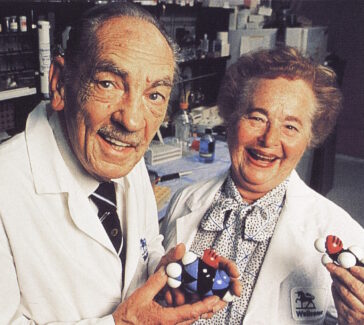Gerhard Domagk
German pathologist Gerhard Domagk was forced to reject the Nobel Prize he won for his discovery of the first sulfa drug.

Prontosil was the first drug to successfully treat bacterial infections and the first of many sulfa drugs—forerunners of antibiotics. This achievement earned its creator a Nobel Prize, which the German authorities forced him to reject.
In the 1920s and 1930s common bacterial infections ran rampant in Europe and the United States. Staphylococcal and streptococcal infections loomed large as killers, along with pneumococcal and tubercular infections. In this environment minor scratches and scrapes could prove deadly, and pneumonia and tuberculosis killed even young adults.
Introduced in 1935 by Gerhard Domagk (1895–1964), sulfa drugs, or sulfonamides, all of which are related to the compound sulfanilamide, provided the first successful therapies for many bacterial diseases. As such, they proved to be the forerunners of antibiotics, showing that bacterial diseases are vulnerable to substances not natural to the human body.
From Academic Medicine to IG Farben
Born the son of a teacher in Lagow, Germany, Domagk decided early in life to become a physician. His medical studies at the University of Kiel were interrupted by his service as a grenadier and medical corpsman in World War I. He completed his medical degree in 1921 and then began an academic career, pursuing research in pathology. He adopted a dynamic approach to pathology, incorporating physiology and chemistry into his work.
In 1927 he was recruited from the University of Münster by the pharmaceuticals division of IG Farbenindustrie, a recently organized industrial conglomerate made up of German companies, including the former Bayer Company, that specialized in dyes (Farben) and other fine chemicals. In this industrial setting Domagk felt at greater liberty to pursue his research and had far better resources at his command than in the university setting. He would spend the rest of his career there. (After World War II, IG Farben was broken up, and the division in which Domagk worked once again became the Bayer Company.)
Domagk was hired to establish a special pharmacology laboratory and to collaborate with two chemists, Fritz Mietzsch and Josef Klarer. They worked together on a research program to test compounds related to synthetic dyes for their effectiveness against disease. Mietzsch had already accomplished his synthesis of Atabrine, a successful substitute for quinine, the natural antimalarial extracted from the bark of cinchona trees. Finding effective substitutes for natural treatments for bacterial diseases was very much on the new team’s agenda due to monopolistic pricing and wartime shortages of natural substances.

The Discovery of Prontosil
In Domagk’s view a drug’s role was to interact with the immune system, either to strengthen it or so weaken the agent of infection that the immune system could easily conquer the invader. He therefore placed great stock in testing drugs in living systems and was prepared to continue working with a compound even after it failed testing on bacteria cultured in laboratory glassware.
Among the hundreds of chemical compounds prepared by Mietzsch and Klarer for Domagk to test were some related to the azo dyes. They had the characteristic -N=N- coupling of azo dyes, but one of the hydrogens attached to nitrogen had been replaced by a sulfonamide group. In 1931 the two chemists presented a compound (KL 695) that, although it proved inactive in vitro, was weakly active in laboratory mice infected with streptococcus.
The chemists made substitutions in the structure of this molecule and, several months and 35 compounds later, produced KL 730, which showed incredible antibacterial effects on diseased laboratory mice. It was named prontosil rubrum and patented as Prontosil. Domagk spent the next three years investigating the antibacterial properties of Prontosil.
He finally published the first report of his findings in 1935. In the intervening three years Prontosil had been successfully used to treat several diseases in humans, of both streptococcal and staphylococcal origins. Among the early patients was Domagk’s own six-year-old daughter, Hildegard, who had contracted a severe streptococcal infection from an unsterilized needle. She recovered but suffered a permanent reddish discoloration of her skin owing to the drug.
The Nobel Prize and Beyond
Domagk’s discovery of the antibacterial properties of Prontosil won him the 1939 Nobel Prize in Physiology or Medicine. However, the Nobel committee had angered the German political authorities by awarding the 1935 Nobel Peace Prize to Carl von Ossietzky, an outspoken German pacifist. Under the grip of Hitler and the Nazi Party, German citizens were forbidden to accept the Nobel Prize. After Domagk accepted the prize, he was arrested by the Gestapo and forced to send a letter rejecting it. Although Domagk was able to receive his prize medal in 1947, the prize money had long since been redistributed.
In their day sulfa drugs developed in Germany and elsewhere were used to good effect to treat, among other conditions, meningitis, childbed fever, pneumonia, blood poisoning, gonorrhea, burns from gas warfare, and other serious burns. But the advent of penicillin during World War II, followed by a host of other antibiotics that were more effective against bacteria, shifted the focus away from Prontosil and the sulfa drugs.
Still, bacteria could become resistant to antibiotics, and in the latter part of his career Domagk turned his attention to the search for an antitubercular drug to replace the already increasingly ineffective streptomycin. Although Domagk and his research team were unsuccessful in finding that replacement, their work contributed to the later discovery of isoniazid—one of the strongest and most reliable antitubercular drugs.
Featured image: Gerhard Domagk. Bayer Corporation



